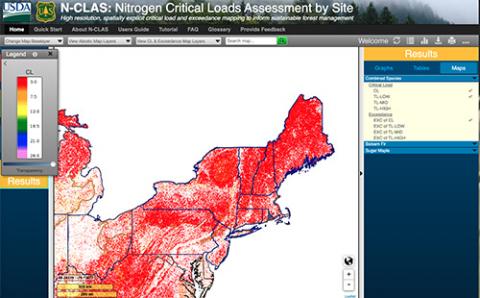Interaction of Climate Change, Nitrogen Deposition, and Pest Disturbance: A Spatial Management Tool for Predicting Effects on Forest Health and Setting Critical Loads

Air pollution, climate change, and pests significantly stress forest ecosystems. Resource managers need information at the same spatial scale as the forests they manage, with detail on individual tree species, to evaluate potential impacts of these stressors. NSRC researchers developed an online geographic information system (GIS) tool, called Nitrogen Critical Loads Assessment by Site (N-CLAS), to assess predicted effects of air pollution (nitrogen deposition) and climate on tree species of management concern in the northeastern United States. The N-CLAS tool uses soil, climate, and air pollution data to predict which tree species are at risk. Tool users select tree species and geographic areas, as well as figure, table, and map output options.
The results generated by N-CLAS predict that most forests in the northeastern United States are at risk of detrimental effects from air pollution, although extent and magnitude of risk varies spatially. Several species demonstrate high sensitivity to air pollution across large portions of the Northeast. Yellow birch, butternut, eastern white pine, bigtooth aspen, quaking aspen, northern red oak, and American elm are consistently the most at risk from air pollution across the mixed stands they occupy. Risks to sensitive tree species are highest in the southwestern part of the region, where air pollution is the greatest.
N-CLAS provides land managers access to a tool with significant refinement in determining air pollution risks at a scale applicable to forest management. This represents an important step towards improving our understanding of the potential risks to forests in the Northeast and linking current science to decision making on the ground.
